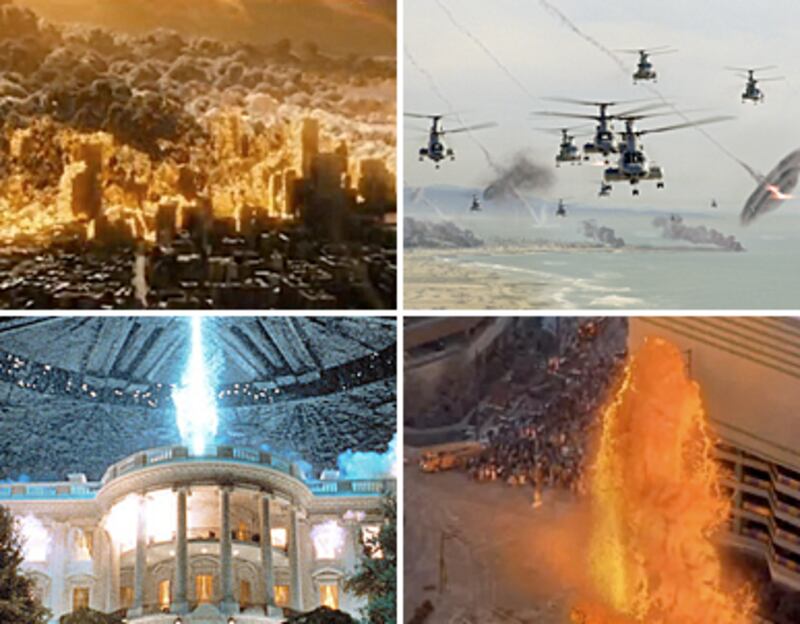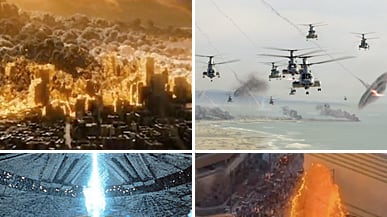Battle: Los Angeles, opening in theaters this Friday, is just one in a long line of Hollywood films that revels in the destruction of a major U.S. city. But why are audiences so obsessed with seeing their metropolitan cities turned to rubble?
It looks like a movie. That was the initial reaction of many stunned viewers upon witnessing footage of two hijacked commercial airliners exploding into the Twin Towers on September 11, 2001. It is a true testament to our Hollywood-saturated culture; one that, in the five years leading up to that fateful morning, paid big bucks to marvel at major U.S. cities being flattened by aliens ( Independence Day), volcanic eruptions ( Volcano), sea monsters ( Godzilla), and meteorites ( Armageddon, Deep Impact).
Gallery: 9 Scenes of Cities Blowing Up

Columbia Pictures’ Battle: Los Angeles is the latest entry in the disaster film canon. As the world crumbles around them, a platoon of Marines, led by Aaron Eckhart, digs in and fights back against alien invaders in the City of Angels. But the movie begs the question: Why are American audiences enthralled by the destruction of their major metropolitan cities?
“I think that most people don’t get to live in these big cities where we have skyscrapers, beautiful cars, and beautiful people, so it’s this wish-fulfillment of getting to destroy these things,” said Neal Moritz, the producer of Battle: Los Angeles. Moritz is no stranger to destroying L.A. His first big Hollywood production was 1997’s Volcano, and he says he believes film audiences, most of which reside in Middle America, relish in the destruction of what he refers to as “the land of excess.”
It’s no coincidence that the top three most destroyed cities on film—Los Angeles, New York, and Washington D.C.—are the entertainment, financial, and political capitals of the country. “There’s a little schadenfreude from everywhere else in the world,” said William Fay, executive producer of Independence Day and Godzilla. “In Independence Day, there are a bunch of people on a rooftop cheering and waiting for E.T. to come down, waving signs like ‘Be Friendly to Aliens,’ and I think that’s definitely playing into Middle America’s perception of L.A.”
It’s no coincidence that the top three most destroyed cities on film—Los Angeles, New York, and Washington D.C.—are the entertainment, financial, and political capitals of the country. “There’s a little schadenfreude from everywhere else in the world,” said William Fay, executive producer of Independence Day and Godzilla.
But there’s more to it than just cultural wish-fulfillment. The specter of 9/11 still looms large. In the years immediately following the attacks, Hollywood was reluctant to embrace the disaster film. One of the first to do so came from a usual suspect: Independence Day helmer Roland Emmerich, but, his 2004 film The Day After Tomorrow placed the blame on global warming. It wasn't really until 2008's Cloverfield, a movie shot in first-person—and rife with 9/11 imagery—about a monster attack on New York City, that U.S. audiences became more comfortable suspending disbelief again.
A common method used by therapists to help patients get over a past trauma is through an imaginal replay of the trauma, and that’s where Hollywood steps in. “If you look at how these cities are blown up, they’re always being blown up in a fantastical way,” said Michael Lynton, CEO of Sony Pictures, Columbia’s parent company. “If the converse were true, and you did a real movie about an authentic terrorist attack, the public’s reaction would be very different. So you use aliens, or the end of the world, but you don’t use stuff that’s realistic.”
On a less serious note, people seem to have an almost primal fascination with destruction. As children, we build sand castles on the beach only to giddily rejoice when they’re washed away by the incoming tide. And the destruction film has enjoyed a long, storied history. “One of the earliest films—before 1900—was of workers demolishing a building and knocking down its last standing wall,” said Dana Polan, professor of cinema studies at NYU’s Tisch School of the Arts. “Evidently, viewers loved seeing it over and over again.”
But the fairer sex isn’t quite as susceptible to these films’ charms, says Claudia Puig, film critic at USA Today. Describing these films as a “male phenomenon,” she says, “The minimal romances thrown in or children in peril is an effort to draw in women that might not get the same thrills of seeing things blow up as men do.”
Then again, in today’s Hollywood, where spectacle triumphs over substance, it could merely be a case of the more kinetic action thrown onscreen, the merrier. Sony Pictures CEO Lynton, who also oversaw the symphony of destruction that was 2012, agrees. “This is the nature of disaster movies,” he says with a slight chuckle.
Marlow Stern works for The Daily Beast and is a masters degree recipient from the Columbia University Graduate School of Journalism. He has served in the editorial dept. of Blender Magazine, as an editor at Amplifier Magazine, and, since 2007, editor of Manhattan Movie Magazine.






